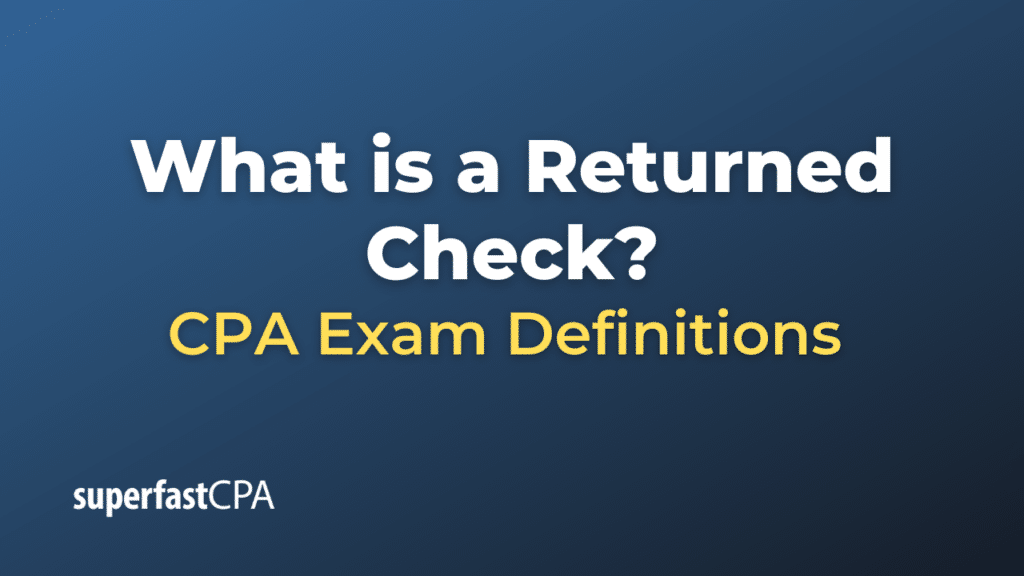Returned Check
A returned check, often referred to as a “bounced check” or “NSF check” (meaning “non-sufficient funds”), is a check that a bank or credit union is unable to process due to a lack of adequate funds in the account of the individual or entity that issued the check. When this occurs, the bank will “return” or “bounce” the check back to the person or business to whom it was written as unpaid.
Here are some key points to know about returned checks:
- Fees: When a check is returned, both the account holder who wrote the check and the recipient of the check may be charged fees. The bank that issued the check will typically charge the account holder an NSF (non-sufficient funds) or bounced check fee. Similarly, the recipient’s bank might charge them a fee for depositing a check that was later returned. Furthermore, the recipient might also charge the payer a fee or penalty for the inconvenience.
- Alternative Collection: If you receive a bounced check, you can usually attempt to deposit it again in case the payer has since added sufficient funds to their account. Alternatively, you can contact the individual or business who wrote the check and request an alternative form of payment.
- Legal Implications: Writing a check when you know you don’t have sufficient funds in your account can be illegal in many jurisdictions. Depending on the amount and whether it’s a repeat offense, intentionally writing bad checks can lead to hefty fines or even imprisonment.
- Credit Implications: If you frequently bounce checks, this can negatively impact your credit score and your standing with your bank. Your bank might even close your account if it happens repeatedly.
- Overdraft Protection: To avoid bouncing checks, some people opt for overdraft protection with their bank accounts. This service typically comes at a fee but will cover the difference if you write a check that exceeds your account balance.
- Clearance Time: Even if you deposit a check and see the funds added to your account, it doesn’t mean the check has cleared. It can take several days for checks to process fully. If you spend the funds before the check clears and it ends up bouncing, you could be faced with overdraft fees.
In the age of electronic transactions and payments, the incidence of returned checks has decreased. However, they still occur, and it’s essential to understand the implications and how to handle them.
Example of a Returned Check
Jane is a freelance graphic designer. She completed a project for a client, Acme Corp., and billed them $2,500 for her services. Acme Corp. sent Jane a check for the amount owed.
Jane, pleased to receive payment, deposited the check into her bank account. A few days later, she logged into her online banking and saw that her account balance had decreased significantly. Upon further investigation, she discovered that Acme Corp.’s check had bounced and her bank had charged her a $35 returned check fee.
Actions Taken:
- Bank Notification: Jane’s bank sent her a notice (either electronically or in paper form) informing her of the returned check and the associated fee.
- Contacting the Payer: Jane promptly reached out to Acme Corp.’s accounting department. They apologized and explained that an oversight led to insufficient funds in the account from which the check was issued.
- Alternative Payment: Acme Corp. offered to wire the payment to Jane’s account directly to avoid any further delay. Additionally, they compensated Jane for the $35 fee she incurred due to the returned check.
- Resolution: Jane received her payment, and the relationship between her and Acme Corp. remained intact, thanks to clear communication and swift action on Acme Corp.’s part.
Lessons Learned:
- Clearance Time: Even after depositing a check, it’s essential to remember that the funds might not have fully cleared. It’s always a good practice to wait a few days before considering the check “safe.”
- Communication: When faced with a financial hiccup like a returned check, clear and prompt communication can help resolve issues smoothly and maintain good business relationships.
- Electronic Payments: Given the potential issues with paper checks, many businesses and individuals are opting for electronic payments (e.g., direct transfers, payment platforms) to reduce the risk of payment issues.
This example underscores the importance of monitoring one’s bank account and understanding the potential challenges of handling paper checks.













